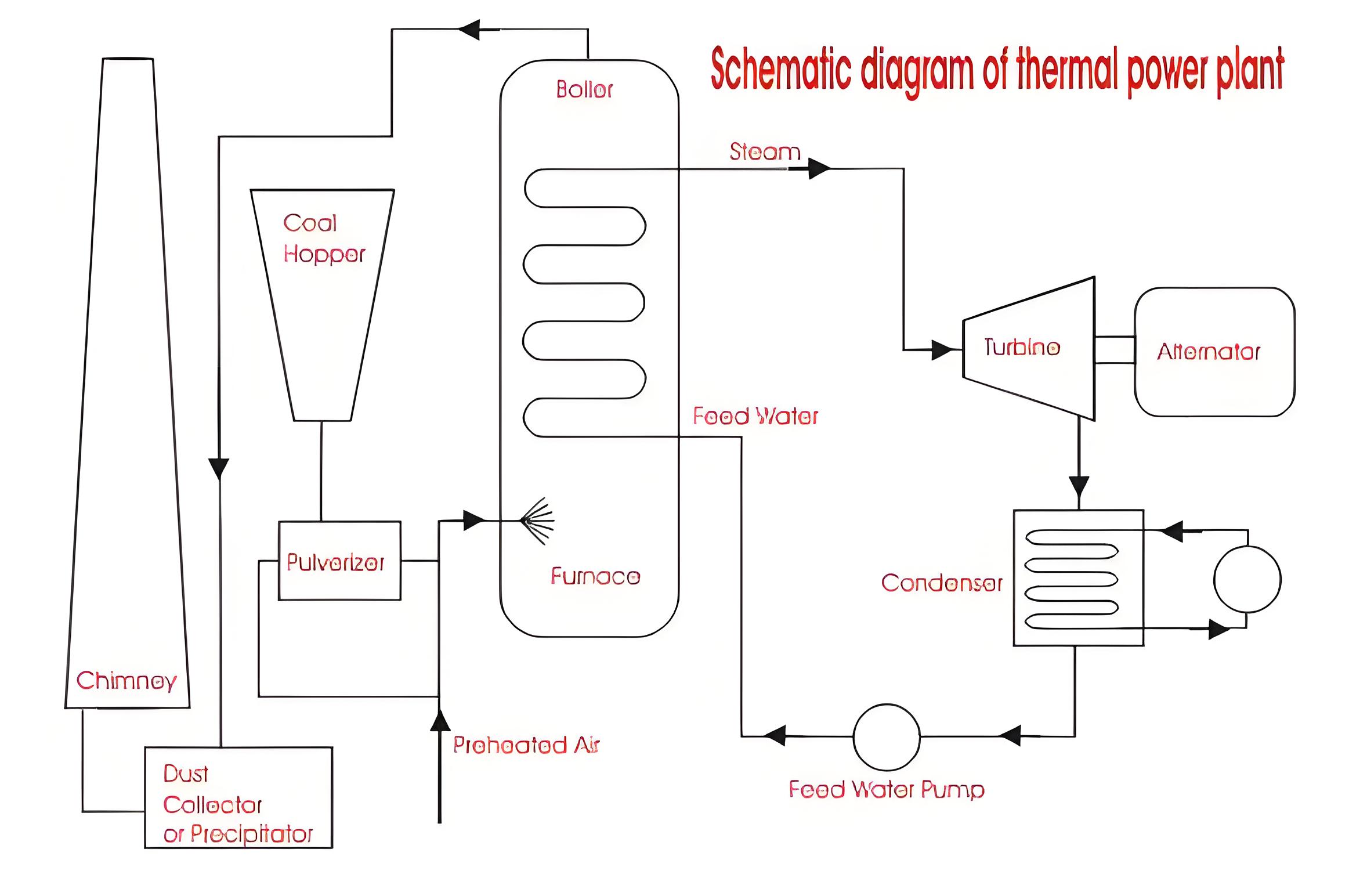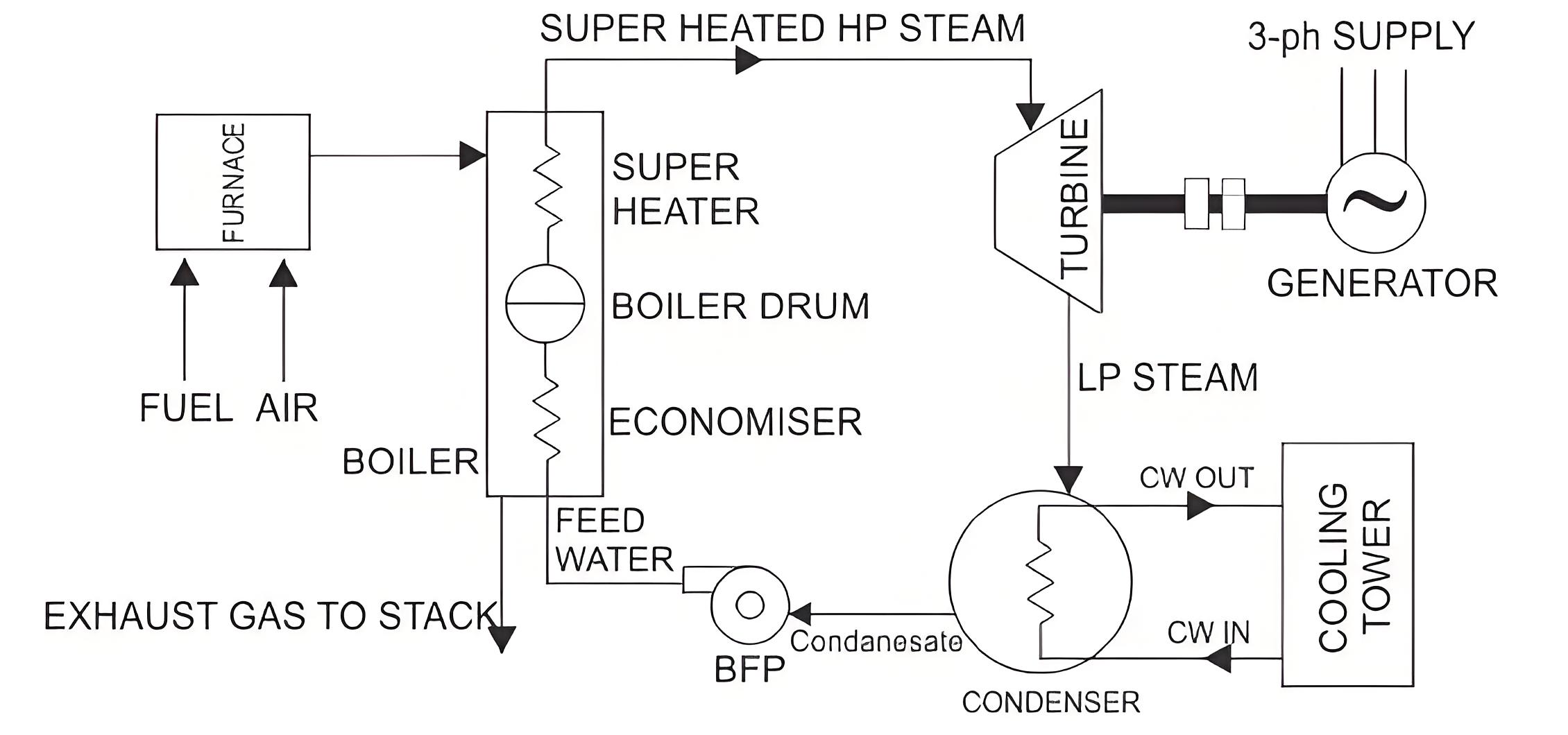Thermal Power Generation
Thermal Power Plant Definition
A thermal power plant is defined as a facility that generates electricity by using heat energy, primarily from burning coal, to produce steam that drives turbines.
Theory of Thermal Power Station
The theory of thermal power stations is simple. These plants use steam turbines connected to alternators to generate electricity. The steam is produced in high-pressure boilers.
Generally in India, bituminous coal, brown coal, and peat are used as fuel for the boiler. The bituminous coal is used as boiler fuel has volatile matter from 8 to 33% and ash content 5 to 16%. To increase thermal efficiency, coal is used in the boiler in powder form.
In a coal thermal power plant, the steam is produced at high pressure in the steam boiler due to the burning of fuel (pulverized coal) in boiler furnaces. This steam is further supper heated in a superheater.
This superheated steam then enters into the turbine and rotates the turbine blades. The turbine is mechanically so coupled with an alternator that its rotor will rotate with the rotation of turbine blades.
When steam enters the turbine, its pressure drops rapidly, causing the steam volume to increase.After imparting energy to the turbine rotor, the steam passes out of the turbine blades into the condenser.In the condenser, the cold water is circulated with the help of a pump which condenses the low-pressure wet steam.
This condensed water is further supplied to a low-pressure water heater where the low-pressure steam increases the temperature of this feed water; it is again heated at high pressure.To understand better, let’s break down the steps of how a thermal power station operates:
First, the pulverized coal is burnt into the furnace of steam boiler.
High-pressure steam is produced in the boiler.
This steam is then passed through the superheater, where it further heated up.
This super heated steam is then entered into a turbine at high speed.
In turbine, this steam force rotates the turbine blades that means here in the turbine the stored potential energy of the high pressured steam is converted into mechanical energy.
Line Diagram of Power Plant

After rotating the turbine blades, the steam has lost its high pressure, passes out of turbine blades, and enters into a condenser.In the condenser, the cold water is circulated with help of a pump which condenses the low-pressure wet steam.
This condensed water is then further supplied to a low-pressure water heater where the low-pressure steam increases the temperature of this feed water, it is then again heated in a high-pressure heater where the high pressure of steam is used for heating.The turbine in the thermal power station acts as a prime mover of the alternator.
Overview of Thermal Power Plant
A typical Thermal Power Station Operates on a Cycle which is shown below.
The working fluid is water and steam. This is called the feed water and steam cycle. The ideal Thermodynamic Cycle to which the operation of a Thermal Power Station closely resembles is the rankine cycle.
In a steam boiler, the water is heated up by burning the fuel in the air in the furnace, and the function of the boiler is to give dry superheated steam at the required temperature. The steam so produced is used in driving the steam Turbines.

This turbine is coupled to the synchronous generator (usually a three-phase synchronous alternator), which generates electrical energy.
The exhaust steam from the turbine is allowed to condense into the water in the steam condenser of turbine, which creates suction at very low pressure and allows the expansion of the steam in the turbine to very low pressure.
The principal advantages of the condensing operation are the increased amount of energy extracted per kg of steam and thereby increasing efficiency, and the condensate which is fed into the boiler again reduces the amount of fresh feed water.
The condensate along with some fresh makeup feed water is again fed into the boiler by a pump (called the boiler feed pump).
In the condenser, the steam is condensed by cooling water. Cooling water recycles through the cooling tower. This constitutes a cooling water circuit.
The ambient air is allowed to enter the boiler after dust filtration. Also, the flue gas comes out of the boiler and gets exhausted into the atmosphere through stacks. These constitute air and flue gas circuits.
The flow of air and also the static pressure inside the steam boiler (called draught) is maintained by two fans called Forced Draught (FD) fan and Induced Draught (ID) fan.The total scheme of a typical thermal power station along with different circuits is illustrated below.
Inside the boiler, there are various heat exchangers, viz. Economizer, Evaporator (not shown in the fig above, it is basically the water tubes, i.e. downcomer riser circuit), Super Heater (sometimes Reheater, air preheater are also present).

In Economiser the feed water is heated to a considerable amount by the remaining heat of flue gas.The Boiler Drum maintains a head for natural circulation of a two-phase mixture (steam + water) through the water tubes.There is also a Super Heater which also takes heat from flue gas and raises the temperature of steam as per requirement.
The efficiency of Thermal Power Station or Plant
The overall efficiency of the steam power plant is defined as the ratio of heat equivalent of electrical output to the heat of combustion of coal. The overall efficiency of a thermal power station or plant varies from 20% to 26% and it depends upon plant capacity.
Advantages of Thermal Power Station
The advantages of a thermal power station include:
Economical for low initial cost other than any generating plant.
Land required less than hydropower plant.
Since coal is the main fuel and its cost is quite cheap than petrol/diesel so generation cost is economical.
Maintenance is easier.
Thermal power plants can be installed in any location where transportation and bulk of water are available.
Disadvantages of Thermal Power Station
The disadvantages of a thermal power station include:
The running cost for a thermal power station is comparatively high due to fuel, maintenance, etc.
A large amount of smoke causes air pollution. The thermal power station is responsible for Global warming.
The heated water that comes from the thermal power plants has an adverse effect on the aquatic lives in the water and disturbs the ecology.
The overall efficiency of the thermal power plant is low like less than 30%.
The Electricity Encyclopedia is dedicated to accelerating the dissemination and application of electricity knowledge and adding impetus to the development and innovation of the electricity industry.













